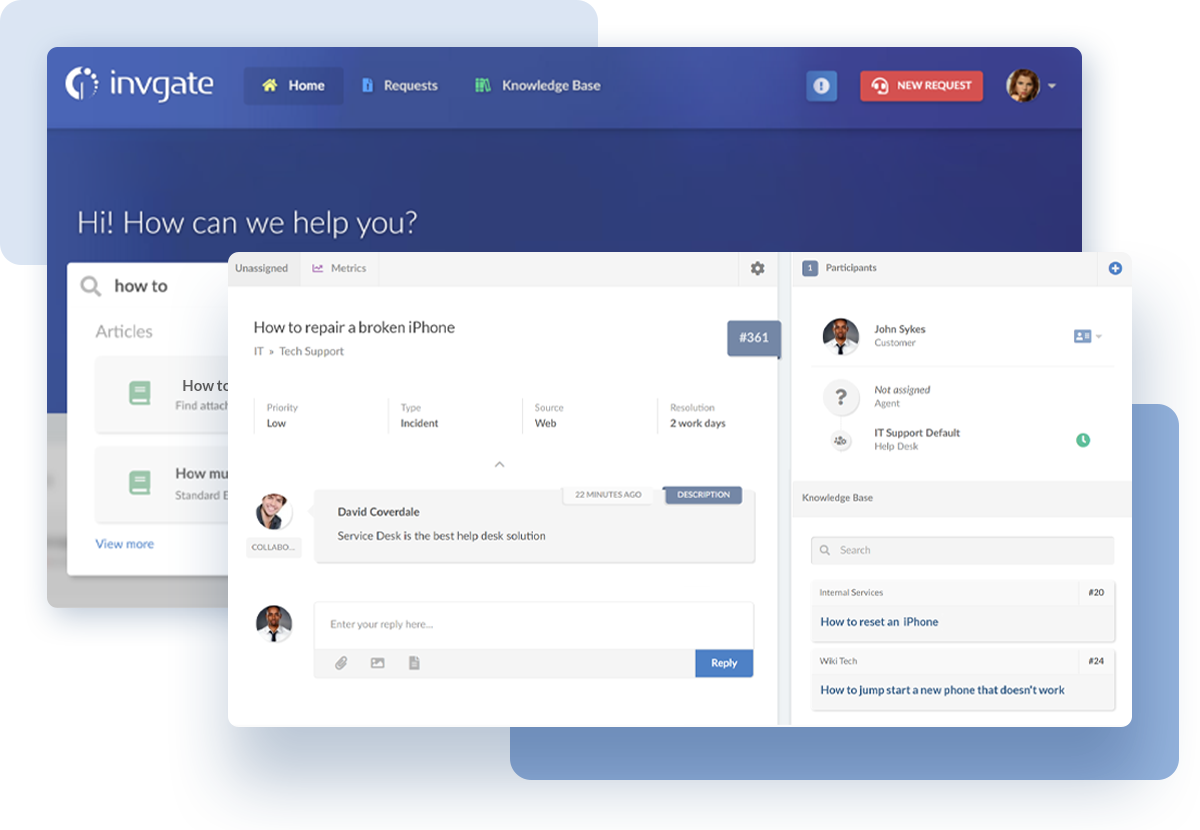In the world of IT Service Management (ITSM), understanding the difference between Content Management vs Knowledge Management is crucial. These two disciplines play distinct yet interconnected roles in how organizations manage information, which can significantly impact business efficiency, decision-making, and innovation.
Knowing the distinctions between these two concepts can help businesses optimize their strategies, ensuring that the right content reaches the right people at the right time while also preserving valuable organizational knowledge. So, what exactly sets them apart, and why should you care?
Let’s delve into the intricacies of Content Management vs. Knowledge Management.

What is Content Management (CM)?
Content Management (CM) refers to the process of collecting, managing, and publishing content across various channels. This includes everything from text, images, and videos to documents and other multimedia elements. The primary goal of CM is to ensure that content is easily accessible, up-to-date, and aligned with the organization's objectives.
Content Management Systems (CMS) help businesses streamline the creation and distribution of content, making it easier for teams to collaborate and maintain consistency across all platforms. By implementing an effective Content Management strategy, organizations can enhance their digital presence and ensure that their messaging remains cohesive.
What is Knowledge Management (KM)?
Knowledge Management (KM), on the other hand, is the practice of capturing, storing, and sharing knowledge within an organization. This includes both explicit knowledge (documents, procedures, manuals) and tacit knowledge (insights, experiences, expertise). The objective of KM is to ensure that valuable knowledge is preserved and accessible to those who need it.
Knowledge Management systems are designed to facilitate the flow of information within an organization, helping employees find the knowledge they need to solve problems, make decisions, and innovate. By fostering a culture of knowledge sharing, organizations can improve efficiency, reduce redundancy, and enhance overall performance.

10 key differences between Content Management vs Knowledge Management
1. Purpose
CM primarily focuses on the creation, organization, and distribution of digital content across various platforms. The purpose here is to ensure that the right content reaches the right audience at the right time, driving engagement, conversions, or education.
This content could range from blog posts and videos to marketing materials and technical documentation. The goal is to maintain a consistent brand voice, enhance customer experience, and support the organization’s marketing and communication strategies.
On the other hand, KM is centered on the collection, organization, and dissemination of knowledge within an organization. The primary purpose of KM is to capture valuable insights, experiences, and expertise from employees and make them accessible to others within the organization.
This facilitates better decision-making, fosters innovation, and helps maintain a competitive edge. Unlike CM, which often targets external audiences, KM is more internally focused, aiming to empower employees with the information they need to perform their tasks effectively.
2. Content vs. knowledge
CM deals with structured content that is often static and designed for a broad audience. This content includes documents, videos, images, and web pages, all of which are created with a specific purpose and audience in mind.
The content is typically managed through workflows that involve creation, review, approval, and publication (this blog post was actually developed with through this kind of workflows). The emphasis is on ensuring that the content is accurate, relevant, and aligned with the organization’s objectives.
In contrast, KM involves both explicit and tacit knowledge. Explicit knowledge is formalized and documented, such as manuals, procedures, and reports, which can be easily stored and shared.
Tacit knowledge, however, is more intangible, residing in the minds of employees, encompassing skills, experiences, and insights. KM aims to capture both types of knowledge, often requiring tools and processes that encourage sharing, collaboration, and continuous learning within the organization.
3. Tools and systems
The tools used for CM are designed to manage the lifecycle of digital content. Content Management Systems (CMS) like WordPress, Drupal, Joomla and HubSpot or website builders like Durable, Wix or Shopify are popular examples. These systems provide a framework for content creation, storage, and publishing, often featuring user-friendly interfaces, templates, and plugins to extend functionality. They help organizations maintain consistency across their digital presence and ensure that content is up-to-date and accessible to their audience.
KM systems, on the other hand, are tailored to facilitate the capture, storage, and retrieval of knowledge. Tools like Confluence, SharePoint, and Guru are commonly used for this purpose. These platforms enable employees to document their expertise, collaborate on projects, and access information when needed. KM systems often include features like search capabilities, knowledge bases, and forums to encourage knowledge sharing and collaboration, ensuring that critical knowledge is preserved and easily accessible.
4. Audience
The primary audience for CM is often external, including customers, partners, and the general public. Content is created with the intent to inform, educate, or persuade these audiences, and it is distributed through various channels like websites, social media, and email campaigns. The goal is to engage these audiences, build brand loyalty, and drive conversions, whether that’s purchasing a product, subscribing to a newsletter, or sharing content with others.
In contrast, KM targets an internal audience, such as employees, managers, and other stakeholders within the organization. The aim is to ensure that everyone within the organization has access to the knowledge they need to perform their jobs effectively. KM fosters a culture of continuous learning and improvement by making knowledge easily accessible, thereby reducing the risk of knowledge loss due to employee turnover and improving overall organizational efficiency.
5. Process
The process of CM is typically linear, involving distinct stages such as content creation, review, approval, and publication. Content is often produced by specific teams, such as marketing or communications, and follows a predefined workflow to ensure quality and consistency.
Additionally, today’s AI writing platforms are increasingly embedded in content production cycles, helping teams streamline creation and maintain consistency. Once published, the content may be updated or archived, but the process is largely one-way, from creation to consumption.
KM, on the other hand, is more cyclical and dynamic. The process involves the continuous collection, sharing, and updating of knowledge. Unlike CM, where the content lifecycle may end with publication, KM requires ongoing interaction and collaboration. Employees contribute knowledge, share insights, and refine existing information based on new experiences or developments. This iterative process ensures that knowledge remains relevant and up-to-date, supporting the organization’s long-term goals.
6. Collaboration
Collaboration in CM is often limited to specific roles involved in the content creation process, such as writers, editors, designers, and marketers. These teams work together to produce content that aligns with the organization’s messaging and branding. Collaboration is typically structured, with clear roles and responsibilities, and may involve tools like project management software to keep the process on track.
KM, however, promotes a more widespread and inclusive approach to collaboration. It encourages employees across all levels and departments to share their knowledge and expertise. Collaboration in KM is less formalized and more organic, often occurring through platforms that support discussion, document sharing, and real-time collaboration. This inclusive approach helps break down silos, ensuring that knowledge flows freely across the organization, leading to better decision-making and innovation.
7. Governance
Governance in CM is crucial for maintaining content quality, consistency, and compliance with industry regulations or organizational standards. This often involves strict control over content creation and approval processes, with designated roles responsible for ensuring that content meets predefined criteria before it is published. Governance in CM helps organizations avoid errors, maintain brand integrity, and ensure that content aligns with strategic goals.
In KM, governance is more focused on fostering a culture of knowledge sharing while ensuring that the knowledge being shared is accurate and reliable. While there may be some level of oversight to ensure the quality of knowledge, KM governance tends to be less rigid than in CM. The goal is to encourage participation and collaboration rather than impose strict controls. This approach helps to create an open environment where employees feel comfortable sharing their knowledge without fear of excessive scrutiny.
8. Metrics
The success of CM is often measured using engagement metrics such as page views, click-through rates (CTR), social shares, and conversion rates. These metrics provide insights into how well the content is resonating with the audience and whether it is achieving its intended objectives, such as increasing brand awareness or driving sales. CM metrics are typically quantitative, focusing on the impact of content on external audiences. When evaluating YouTube creators and video content, teams can use a Youtube engagement analytics tool to calculate engagement rates for channels or individual videos and check influencers before partnering, ensuring CM metrics directly inform distribution and collaboration decisions.
In contrast, KM metrics are more qualitative and focus on the impact of knowledge sharing within the organization. Metrics might include the frequency of knowledge contributions, the number of times knowledge is accessed or utilized, and the outcomes of decisions informed by shared knowledge. KM success is often measured by improvements in efficiency, innovation, and problem-solving within the organization, reflecting the value of knowledge in driving business outcomes.
9. Scalability
CM systems are designed to scale with the volume of content as an organization grows. As the demand for content increases, CM systems must handle larger amounts of data, more users, and a greater variety of content types. Scalability in CM is often about maintaining performance and usability as the content ecosystem expands, ensuring that content remains accessible and manageable regardless of scale.
KM scalability, on the other hand, involves managing the complexity and diversity of knowledge within an organization. As the organization grows, so does the volume of knowledge, which can make it challenging to ensure that relevant knowledge is easily accessible. KM systems must be able to adapt to this growing complexity, enabling the organization to capture, store, and retrieve knowledge efficiently. Scalability in KM is about maintaining the effectiveness of knowledge sharing even as the organization evolves and expands.
10. Integration
CM systems are often integrated with marketing automation, CRM, and analytics platforms to streamline content distribution and track performance. Integration in CM is about creating a seamless workflow from content creation to publication and beyond, ensuring that content is delivered to the right audience through the right channels. This integration helps organizations optimize their content strategies and improve their overall digital presence.
KM systems, however, are typically integrated with internal communication and collaboration tools, such as intranets, messaging platforms, and project management software. This integration is essential for facilitating knowledge sharing across the organization, enabling employees to access the information they need in the context of their daily work. Effective integration in KM ensures that knowledge is not siloed but is instead seamlessly embedded into the organization’s workflows, supporting continuous learning and collaboration.
What is a Content Management System (CMS)? 3 Options to Choose From
Content Management Systems (CMS) are tools that help organizations manage their digital content. Here are three popular CMS options:
1. WordPress
WordPress is one of the most widely used CMS platforms, known for its flexibility and ease of use. It supports a wide range of plugins and themes, making it ideal for businesses of all sizes.
2. Drupal
Drupal is a powerful CMS that offers advanced customization options and robust security features. It’s a preferred choice for organizations with complex content management needs.
3. Joomla
Joomla is a user-friendly CMS that strikes a balance between simplicity and functionality. It’s suitable for both beginners and experienced developers.
What is a Knowledge Management system? 3 options to choose from
Knowledge Management Systems (KMS) help organizations capture, store, and share knowledge. Here are three popular KMS options:
1. InvGate Service Management
 InvGate Service Management is a powerful tool that extends beyond traditional ITSM to offer Knowledge Management capabilities. It enables organizations to capture and share valuable knowledge through its integrated knowledge base, making information readily available to employees when they need it most.
InvGate Service Management is a powerful tool that extends beyond traditional ITSM to offer Knowledge Management capabilities. It enables organizations to capture and share valuable knowledge through its integrated knowledge base, making information readily available to employees when they need it most.
With features like article versioning, categorization, and search functionality, InvGate Service Management ensures that both explicit knowledge (such as guides and documentation) and tacit knowledge (such as insights from experienced team members) are easily accessible, improving efficiency and reducing redundancy.
In addition to its knowledge base, InvGate Service Management facilitates collaboration and knowledge sharing across departments through its intuitive interface and customizable workflows.
By integrating Knowledge Management into the broader service management framework, InvGate Service Management helps organizations maintain a continuous flow of information, empowering employees to solve problems faster and make informed decisions.
Its ITIL-certified capabilities ensure that knowledge is managed in alignment with best practices, contributing to overall service quality and organizational success.

2. Confluence
Confluence by Atlassian is a collaboration tool that helps teams share knowledge and collaborate on projects. It’s widely used for creating and managing knowledge bases.
3. Guru
Guru is a knowledge management tool designed to capture and organize information within teams. It integrates with various communication platforms, making it easy to access knowledge on the go.
Conclusion
Understanding the differences between Content Management and Knowledge Management is essential for businesses looking to optimize their information management strategies. While both CM and KM play vital roles, they serve different purposes and require distinct approaches.
By implementing the right systems and practices, organizations can ensure that they effectively manage both content and knowledge, leading to improved efficiency, collaboration, and decision-making.
Frequently Asked Questions (FAQs)
1. What is the main difference between Content Management and Knowledge Management?
The main difference is that Content Management focuses on the creation and distribution of content, while Knowledge Management is about capturing and sharing knowledge within an organization.
2. Can a CMS be used for Knowledge Management?
While a CMS is primarily designed for managing content, some systems offer features that support knowledge management, but they are not as specialized as dedicated KMS.
3. Why is Knowledge Management important for businesses?
Knowledge Management is crucial for preserving valuable organizational knowledge, improving decision-making, and fostering innovation by making information accessible to employees.














.jpg?upsize=true&upscale=true&width=780&height=205&name=ITIL%20Foundation%20Exam%20(2).jpg)
